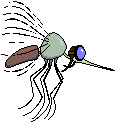



| Sequence Source Links | ||||||
|
||||||
| Database Satistics | |||
|
|||
Dengue fever is a disease caused by the Single-stranded RNA flavivirus. It is spread by Aedes Mosquitoes and is endemic to the tropical regions. The virus circulates as four immunologically distinct serotypes. Despite this diversity dengue fever is normally characterized by similar symptoms: fever, joint pain and vascular leakage.
It is currently classified as an emerging or re-emerging infectious disease by the WHO. Dengue fever (DF) and dengue haemorrhagic fever (DHF)/dengue shock syndrome (DSS) occur in over 100 countries, with more than 2.5 billion people at risk and an estimated 50 million infection per year.
...........Dengue Fever |
|
| Epidemiology | This disease was first described 1780, and the virus was isolated by Sabin 1944. Dengue virus infection is the most common arthropod-borne disease worldwide with an increasing incidence in the tropical regions of Asia, Africa, and Central and South America. There are four serotypes of the virus. All are transmitted by mosquitoes, which are not affected by the disease, although an infected mosquito may infect others (not via man). |
| Pathogenesis | Primary infection may be asymptomatic or may result in dengue fever. This is generally a self-limiting febrile illness which occurs after a 4-8 day incubation period. It has symptoms such as fever, aches and arthralgia (pain in the joints) which can progress to arthritis (inflammation of the joints), myositis (inflammation of muscle tissue) and a discrete macular or maculopapular rash. In this situation clinical differentiation from other viral illnesses may not be possible, recovery is rapid, and need for supportive treatment is minimal. Mongkolsapaya J, et al. Original antigenic sin and apoptosis in the pathogenesis of dengue hemorrhagic fever. Nature Med. 2003 9: 921-927 |
| Dengue haemorrhagic fever | DHF is a potentially deadly complication. The incubation period is unknown but is likely to be similar to that of dengue fever. Dengue hemorrhagic fever commences with high fever and many of the symptoms of dengue fever, but with extreme lethargy and drowsiness. The patient has increased vascular permeability and abnormal homeostasis (homeostasis is the maintenance of equilibrium, or constant conditions, in a biological system) that can lead to hypovolemia (abnormal decrease in blood volume) and hypotension (drop in blood pressure), and in severe cases, result in hypovolemic shock (Shock due to a decrease in blood volume) often complicated by severe internal bleeding. |
| Dengue shock syndrome | DSS results from leakage of plasma into the extravascular compartment. Rapid and poor volume pulse, hypotension, cold extremities, and restlessness occur. In addition to the plasma leakage, which is the result of generalized vasculitis, disseminated intravascular coagulation is present. Dengue shock syndrome is usually a progression of dengue haemorrhagic fever and is often fatal. The four serotypes of dengue virus that have 60-80% homology to each other. Infection with one dengue serotype provides lifelong homologous immunity but limited heterologous immunity. Almost all patients with DHF have had previous experience with at least one of the four serotypes of dengue viruses. Upon infection, the immune response produced specific antibodies to that subtype's surface proteins that prevents the virus from binding to macrophage cells (the target cell that dengue viruses infect) and gaining entry. However, if another subtype of dengue virus infects the same individual, the virus will activate the immune system to attack it as if it was the first subtype. Antibodies are produced to combat the sub type previously encountered. These antibodies bind to the surface proteins but do not inactivate the virus. Reference: Of cascades and perfect storms: the immunopathogenesis of dengue haemorrhagic fever-dengue shock syndrome (DHF/DSS). Immunol Cell Biol. Nov 28 2006 |
About Dengue... |
|